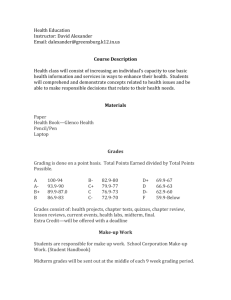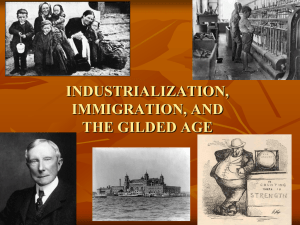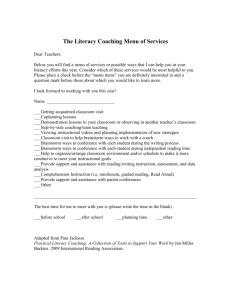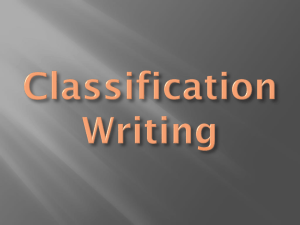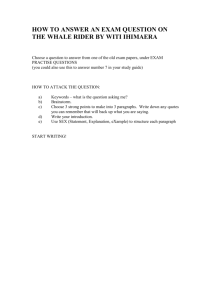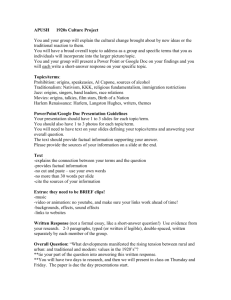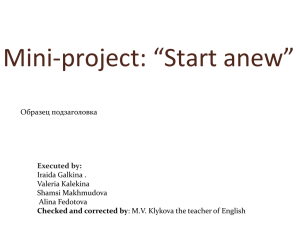EQAO Literacy test student presentation
advertisement
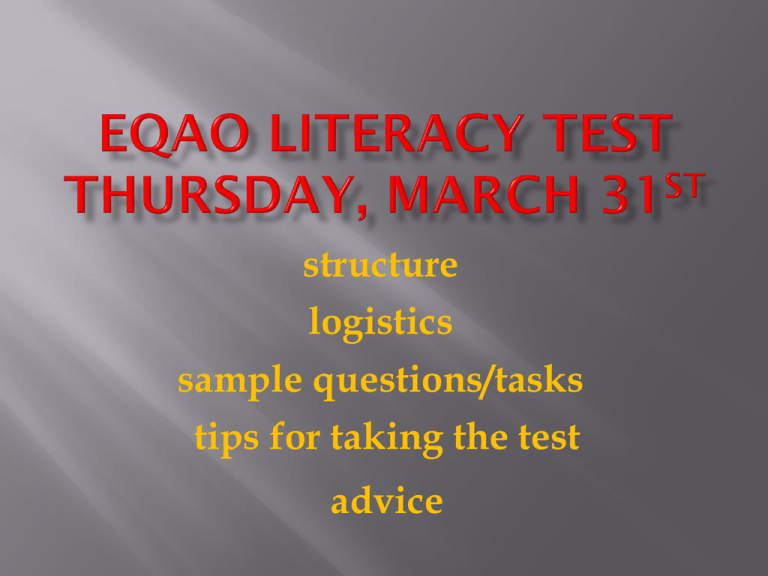
structure logistics sample questions/tasks tips for taking the test advice The OSSLT is a provincial test of literacy (reading and writing) skills students have acquired by Grade 10. It is based on the literacy skills expected in The Ontario Curriculum across all subject areas up to the end of Grade 9. It is a graduation requirement. Administration Date: March 31, 2011 Test Materials: 2 test booklets, with one Student Answer Sheet Duration: 2.5 hours of testing time in total Results: an Individual Student Report indicating whether you are successful or unsuccessful (mid-June 2011) STUDENTS WRITING THE LITERACY TEST WARNING 8:15 8:20 – 8:30 Instructions 8:30 – 9:45 Booklet 1 BREAK 9:45 – 9:55 WARNING 9:55 10:00 – 11:15 Booklet 2 LUNCH 11:20 – 12:00 ALL STUDENTS (including those that wrote the literacy test) WARNING 12:05 Period 1 12:10 – 1:15 Period 5 1:20 – 2:24 How long will it take me to write the test? The allotted time for each of the two sessions is one hour and 15 minutes. It is very important that you manage your time properly to complete the entire test. You can take the test again the following year. You can also talk to your parents or guardians and your school principal and/or teacher about taking the Ontario Secondary School Literacy Course (OSSLC) instead of retaking the test. The tests and writing rooms are organised in alphabetical order – not by homeroom. Homeroom teachers will give inform you of your writing room – please write it down. Lists will also be posted in the Main Office windows. Trial Run – Wednesday before Period 2 a couple of pens/pencils an eraser a highlighter Kleenex …. no cell phones, Ipods, or electronic devices of any kind You will not be allowed to leave early – you will sit and wait until the time is up. The teacher supervising your room will call the Main Office, and an adult will escort you to and from the bathroom. Reading selections: Writing Tasks information paragraph (approx. 225 to 250 words long) – news report – dialogue/story (approx. 225 to 250 words long) – real-life narrative (approx. 600 words long) - graphic (fewer than 150 words) 2 long-writing tasks – news report (one page) – series of paragraphs expressing an opinion (two pages) Types of questions: • multiple-choice • open-response (six lines each) 2 short-writing tasks (generally opinion questions - six lines each) What are they looking for? – developing a main idea with supporting details – organization of ideas – language conventions In 2006, the Canadian Museum of Civilization (CMC) celebrated its 150th birthday as an important centre for the preservation and presentation of Canadian heritage. It is one of the most visited museums in the world. Nearly 1.4 million visitors a year marvel at its collection and also at the building itself. Architect Douglas Cardinal designed the curving shape of the building to emulate the way Canada’s rocky landscape was carved by glaciers and rivers. The Grand Hall, which is shaped like a canoe, displays the world’s largest collection of totem poles as well as six Pacific coast Aboriginal houses. The forest backdrop, stretching the full length of the hall, is the world’s largest colour photograph. The museum’s first exhibits in 1856 were a few glass cases containing rocks, minerals and Aboriginal artifacts such as stone tools, pipes and pottery collected by geologists and explorers. Over the years, the collection developed along with the country, becoming more diverse and modern. Today, the CMC’s collection includes items from the ancient past to the present day, from gigantic Haida canoes to a guitar used by rock star Randy Bachman (of the group the Guess Who). Only a portion of the museum’s acquisitions is on display at once, but over 50 000 artifacts can be seen online. About 10 million people around the world log on to the museum’s Web site each year. Real and virtual visitors to the CMC have found a rewarding way to explore Canada’s rich and varied history and culture. Grand Hall 1. a. b. c. d. The Grand Hall is shaped like a canoe because it honours the architect accommodates more visitors represents Aboriginal heritage permits more artifacts to be displayed 2. Which of the following items are contrasted in this reading selection? a. past and present visitors b. rocky and flat landscapes c. early and modern artifacts d. Aboriginal and present-day houses 3. Which word is closest in meaning to “emulate” as used in line 5 of this selection? a. imitate b. disguise c. advertise d. designate underline/circle/highlight key words in the question always read all of the choices – a) might look like a good answer, but it might not be the best answer eliminate the answers you know are wrong think of these as true/false questions get rid of answers with negatives or absolutes read slowly and reread the question & answers to make sure you’re reading what’s actually written remember, you’re looking for the best answer answer every question Read and reread the question carefully. Keep your answer within the six lines provided. Answer the question using specific and relevant details and information from the reading selection. Make connections between the ideas and information in the reading selection and your own experience. Reread your response and correct any errors you notice. For example: Summarize this selection. Include a main idea and one detail that supports it. Poor Answer – too vague; no detail Better Answer – main idea expressed; specific example given Opening and closing sentences - and they have to match! Read and reread the question carefully. Think of connections between the topic and your knowledge & personal experiences – always give an example. Answer the question using specific details and relevant information. Reread your response and correct any errors you notice. Student volunteers improve school grounds Task: Write a news report based on the headline and picture on the next page. • You will have to make up the facts and information, answering some or all of the following questions: Who? What? Where? When? Why? How? • You must relate your newspaper report to both the headline and the picture. Purpose and Audience: to report on an event for the readers of a newspaper Length: The lined space provided for your written work indicates the approximate length of the writing expected. -no paragraphing -no lead -no direct quotation -doesn’t answer Where? When? -expresses an opinion – bias -clear paragraphing - lead answers Who? What? Where? When? -specific details to explain what, how and why -no opinion expressed -still no direct quotation Look closely at the headline and picture. Think of an event that relates to them. Brainstorm, brainstorm, brainstorm! Make up the information and specific details/facts as you answer some or all of the following questions: what, how, why? Your lead/first paragraph must answer these questions: Who? What? Where? When? Write your report using the third person. Poor Answer -too short -opinion is inconsistent -no details or specific reasons for opinion -no facts or examples -still too short -opinion is inconsistent -few details - vague reasons for opinion – good ideas from the first paragraph are not developed -no facts or examples -poor organisation -a bit short -opinion is clear and consistent -sufficient details -general reasons for opinion -facts and examples are supplied -organisation is okay Read the topic question and decide what position you will take in your response. Stick to your position! – no flip-flops! Clearly state your opinion at the beginning of your response. Write at least three paragraphs. Include an introduction, 1-2 body paragraphs and a conclusion. Support your opinion with reasons and relevant examples or facts. Make sure the divisions between paragraphs are clear. Answer every question – even if you’re guessing! Brainstorm your answers – especially for the long writing tasks Read the selections, read the questions, then read the selection again Read carefully! Fill the lines – if you’re typing, fill half! Don’t go over – they won’t mark what’s not on a line. Choose to do the harder/longer tasks first.
